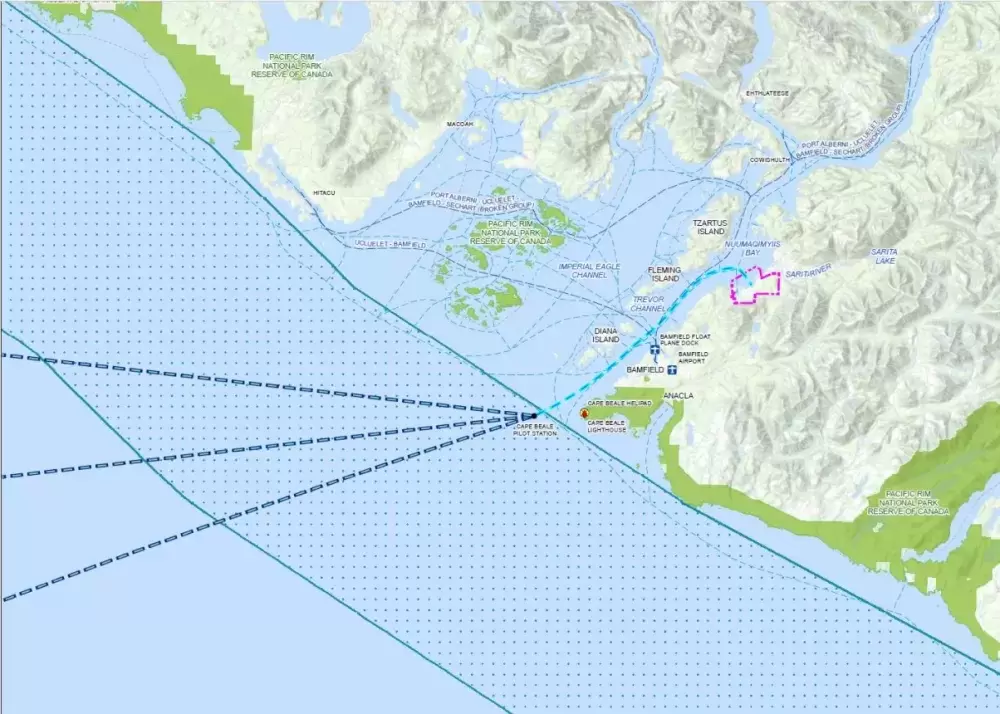The future of an LNG export facility in Sarita Bay - and the hundreds of jobs that it would bring to Huu-ay-aht land – remains in limbo as the Vancouver Island First Nation awaits an update from its partner in the project.
With a final investment decision expected for 2020, progress on the $18-billion project froze when a Feb. 15 letter to Huu-ay-aht citizens from Chief Councillor Robert Dennis Sr. and Tayii Ha’wilth +iis^in, Derek Peters, said that Steelhead LNG “has ceased current project work”.
For the time being Kwispaa LNG’s project description remains with federal and provincial regulators, but their assessment of the project is on hold.
The [Environmental Assessment Office] has been notified by Kwispaa LNG Limited Partnership that work on the Kwispaa LNG project has been put on pause,” stated an email from the B.C. Ministry of Environment. “As a result, the EAO will not be advancing the environmental assessment of the project at this time and will not resume the assessment until receiving notice from the proponent that they will be resuming work.”
News of halting work on Kwispaa came after a long succession of developments since the Huu-ay-aht and Steelhead announced they would be pursuing the partnership in 2014. As recently as Jan. 16 an addendum was sent to the Canadian Environmental Assessment Agency, detailing routes that tankers would transport condensed natural gas from Sarita Bay across the Pacific.
“It is expected that LNG carriers departing the Kwispaa LNG project area will head due west towards LNG customers in Asia,” wrote Tracy Young, Steelhead’s environmental and regulatory manager, in the submission. “It is not anticipated that LNG carriers would deviate from the most direct route and sail northwest along the coastline of Vancouver Island.”
Kwispaa is among more than a dozen LNG projects listed by the provincial government that are in various stages of development in B.C. LNG Canada leads this pack as the first project to begin construction, thanks to investment approval last fall from Shell Canada, Petrochina, the Korean Gas Corporation and Mitsubishi. Under the consent of the Haisla Nation in their territory near Kitimat, LNG Canada is expected to cost $40 billion.
Royal Dutch Shell has predicted a global LNG supply shortage by the middle of next decade if more export terminals aren’t built. John Jack, a Huu-ay-aht councillor and the director of the First Nations LNG Alliance, sees this as an opportunity for Indigenous communities beyond forestry and fishing.
“Making sure that First Nations can benefit from that economic development and that economic activity is something that should be key in the minds of First Nation leaders,” he said. “If we can’t rely on the feds, can’t rely on the province, can’t rely on the courts to provide constant revenue to do what we need to do, then we need to find other ways.”
Not all LNG projects in development will progress to construction, with WCC LNG near Prince Rupert being the latest major initiative to be taken out of consideration when Exxon Mobil withdrew its environmental assessment application in December.
Then in January the Coastal GasLink pipeline through central B.C. faced a roadblock when hereditary chiefs of the five Wet’suwet’en clans opposed the construction through their territory. This opposition drew national attention and led to multiple arrests at the site. Coastal GasLink had agreements with elected councils and First Nations along the pipeline route, but not the hereditary chiefs who led the blockade.
In a release from the First Nations LNG Alliance, Wet’suwet’en Chief Councillor Vivian Tom criticized the influence of outsiders on her territory.
“I don’t mind environmentalists coming into our territory, but when they try to stop everything we have to think no,” she said. “I am really thankful that we are going to have employment [from LNG development] in our nation. It’s exciting.”
For an LNG project to work, Jack believes “First Nations need to be involved from the very beginning”.
“We need the resources to get to a point where we’re living sustainably once more,” he said. “You have to really look at balancing what you want to see from your traditional lifestyle, your traditional economics, as well as providing modern economic opportunities for your people through employment - which is generally speaking what people are going to pick over and above a traditional lifestyle, because from a hunting, fishing and gathering perspective we don’t have the infrastructure or the governance for that to work the way it did in the past.”







